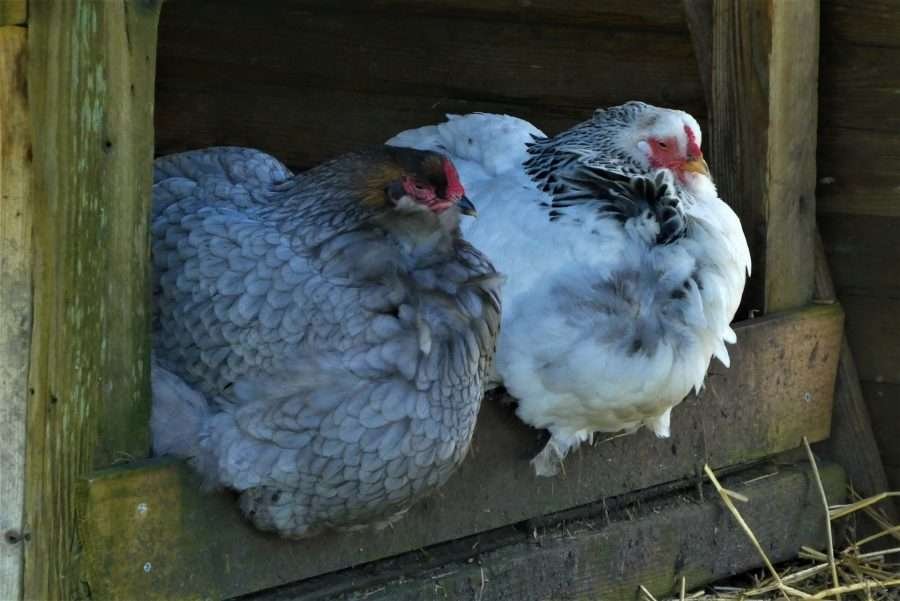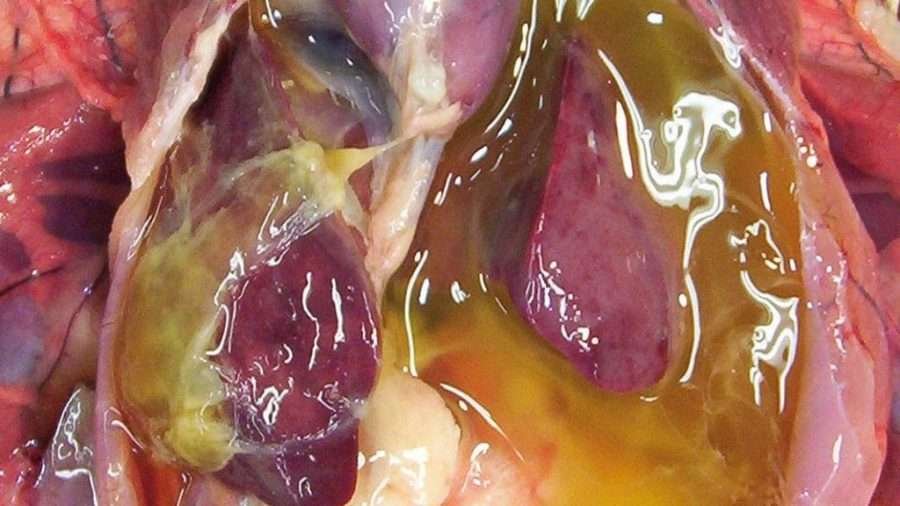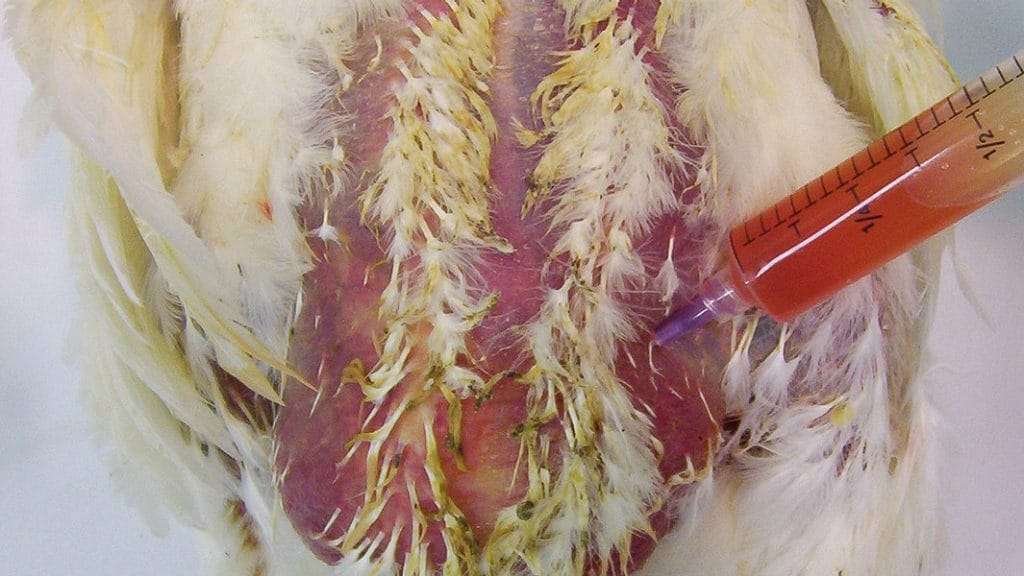Have you noticed a chicken in your flock waddling around with a large fluid filled abdomen or ‘water belly’? Water Belly in chickens, is a common problem especially in older laying hens. It is not a disease, and thankfully not contagious to the rest of your flock. However this condition does need urgent attention and unfortunately is eventually fatal.

Water Belly or the medical term ‘Ascites’ is a condition that causes a yellowish-colored fluid to accumulate in the chicken’s peritoneal or abdominal cavity. This fluid comes from the liver and most commonly occurs due to pulmonary hypertension syndrome.
Having this syndrome reduces the speed at which blood is circulated and the body is oxygenated. As a result, the heart goes into overdrive, trying to compensate for this deficit in circulation and oxygenation. This circumstance then puts extra stress on the chicken’s liver, which starts leaking fluid into the chick’s abdomen.
What this article covers
Below are some quick links. Click any of them to go straight to the section you are interested in – or just carry on reading for the full article!
Symptoms of Water Belly in Chickens?
Causes of Water Belly in Chickens
How to Prevent Water Belly in Chickens
Treating Water Belly in Chickens
Symptoms of Water Belly in Chickens?
Your chicken may be suffering from water belly if you notice the following symptoms –
Swollen abdomen: This often feels squishy to the touch and is soft and distended. It also looks full of fluid.
Red skin: This can often be found around the abdomen, which in many cases, will be missing feathers.
Inhibited movement: The affected chicken will waddle when it walks.
Dyspnoea (Labored breathing): The infected bird will often struggle to breathe and look like it is panting. This is usually accompanied with gurgling sounds. This mostly occurs because the bird’s body is craving oxygen.
Cyanosis: The comb or wattle will have a blue or purple tint. As the chicks’ bodies struggle for oxygen, it will prioritize the more vital organs, relegating non-vital organs such as wattles to the bottom of the list. The blue, purplish color occurs due to a lack of oxygen in these extremities.
Lethargy and lack of appetite: The infected bird will always appear tired and won’t feed at the same rate as the others. In some cases, it could go for an entire day without food. Lack of feeding may result in stunted growth and poor development.

Causes of Water Belly (Ascites) in Chickens
Genetics and rapid growth have been traditionally blamed for water belly in poultry, however a combination of different factors is the usual cause leading to water belly in chickens.
A combination of the below factors are the general cause of a chicken developing water belly or ascites:
- Genetics. Some chicken breeds are more susceptible to water belly than others. Broiler chickens, for example, tend to have issues with ascites more than egg producing chickens due to their breeding for accelerated growth.
- Age. Deterioration from old age can cause water belly in chickens.
- Upper respiratory issues. If you notice that your chickens are suffering from multiple respiratory infections, they also have an elevated risk of heart-related diseases. When there is a lower amount of oxygen, it could make the heart work much harder.
- Environmental stress. Heat can cause stress on the organs and electrolyte imbalances. Improper ventilation, unsanitary conditions, temperature extremes and other poor conditions may also lead to ascites.
- Nutrition. If your chickens eat too many fatty foods or have a too high protein intake, it increases their chance of obesity. Being overweight may lead to hypertension or heart failure. Additionally, if you feed your chickens any moldy or stale food, the aflatoxins may cause enough liver damage to cause water belly.
- High altitude. The higher the elevation at which you live, the harder it is for your heart to pump oxygen through the body. If your chickens are not getting enough oxygen, the strain is too much for the heart.
- Mold. Another pathogenic agent is a mold, Aspergillus fumigates, occasionally present in the environment of all poultry. Disease caused by this mold, so-called ”brooder pneumonia”, forms mould colonies in the lungs, and produces hard nodular areas leading to air sac infection and subsequently to the development of ascites.
- Endotoxins. A considerable number of ascites syndrome in broiler flocks is caused by microorganisms. Most of the Gram-negative bacteria (E. coli, Salmonella sp., Campylobacter) are considered pathogenic because of their lipopolysaccharide (LPS) layer. For example, respiratory exposure to E. coli can amplify the incidence of ascites five-fold in broilers. It is known that Salmonella typhiumurium may cause up to 79% mortality in one week old chickens. However, in some studies lesions of salmonellosis were reported for 4 to 6 week old broilers with E. coli co-infection consequentially leading to ascites.

How to Prevent Water Belly in Chickens
While many of the risk factors for developing water belly are out of your control, there are a few things you can do to raise healthy chickens who are resilient to water belly.
Just like human hearts, chicken hearts respond best to a balanced, nutritious diet, plenty of fresh air & exercise and a low stress life.
Regularly cleaning your chicken coop and run area and ensuring it has proper ventilation, giving your chickens quality feed and fresh, clean water will go a long way in raising healthy, robust chickens with long life spans.

Treating Water Belly in Chickens
Unfortunately this condition will eventually result in death no matter what treatment you give your affected chicken. Water belly cannot be cured entirely. You can treat water belly by doing manual draining to make your chicken more comfortable but due to water belly being incurable, some chicken owners choose to euthanize their chickens immediately. If you feel your chickens condition is too advanced please seek a veterinarian immediately for assessment and advice.
If you would like to make your chicken more comfortable and delay the inevitable you can drain their belly of the fluid.

Draining Water Belly
Belly draining is the best way to relieve the symptoms of ascites. You can go to a veterinarian to undertake this procedure or you can do it yourself at home. Doing it yourself is pretty straightforward and can save time and money as well.
This means that you must draw the fluid out out of the chickens belly with a needle. This may not be for the squeamish but you will be giving your chicken a lot of relief with this procedure.
Here is what you will need:
- Rubbing alcohol
- Bowl
- Protective gloves
- Antibiotic spray
- 60 cc syringe with a 18 gauge needle (Some people prefer to use a 30 cc syringe and 20 gauge needle – as in the video below)
- Sharps container
- Puppy pads
How To Drain Your Chicken’s Water Belly At Home in 5 Steps
Using the above listed items, follow these steps below:
1. Gently pick up your chicken (or have someone hold the chicken for you) and hold them with their rear end (vent) facing you. The best method is by doing a football hold.
2. On the right side of the chicken, near their vent ( about 2 inches away from the vent) locate the site the needle will enter to start draining and sterilise the injection site with rubbing alcohol. You must inject on the right side of the chicken as the left side is where their organs are located.
3. Ensure that the syringe is sterilized and all air removed from the tube. Gently insert the needle. Start to draw out the fluid (slowly), which will be a pale yellow. This is a sign that the kidneys are not functioning properly. If the fluid is either black or green, it could mean that your chicken has an infection. Green or black fluid also means that you are going to have to contact a vet for antibiotics.
4. Take your time and avoid drawing out too much liquid at one time. Look for signs of blood in the syringe and stop if you see it. It should only be about a cup and half of liquid per day. When the syringe is full, twist it off from the needle and leave the needle in the chicken and attach a fresh sterilized needle to the syringe. Keep draining to the recommended volume until finished. The puncture wound will continue draining slowly over the course of the next couple of days. Do not reuse the same needle, dispose of the used needle responsibly in an appropriate sharps container.
5. Once finished draining your chicken’s water belly, put some antibiotic spray on the puncture site. Keep your chicken isolated from the rest of the flock for a couple of days to drain and recover. Use the puppy pads or other absorbent material to soak up the fluid still draining. If drained correctly, the next draining session can wait for 2-3 months.
Supplementation with Vitamins
One of the best ways to assist with water belly is to supplement your chicken’s meals with some oil of oregano and vitamin C. These two ingredients can relieve some of the symptoms of water belly. While vitamin C and oil of oregano will not be a complete cure, they will boost the chickens immunity and oxygen levels. We recommend using liquid products such as oil or oregano drops or liposomal vitamin c as they are easy to get into your chickens mouth or mix in with some treat food making it more likely for your chicken to digest it.
Give Smaller Meals
Most chicken keepers give their chickens once larger meal per day however, giving your chicken smaller amount of food throughout the day can reduce the amount of fluid that builds up in the abdomen. Smaller feedings can reduce the risk of obesity and also prevents chickens having too much protein at one time.
References
Ascites – https://poultryhealth.ca/ascites-water-belly/
Ascites in Chickens – https://www.dsm.com/anh/challenges/supporting-animal-health/ascites-in-chickens.html#:~:text=Ascites%20in%20chickens%2C%20commonly%20referred,dietary%2C%20environmental%20and%20genetic%20factors.
Bumblefoot is another common health condition that chickens can face. Learn how to treat this foot infection at home by reading our guide here.
Chicken Care Shopping List
Are you looking for a shopping list of everything you need when caring for your precious flock? We have put together an easy reference of items for your convenience.

